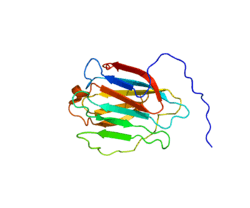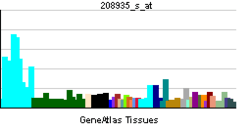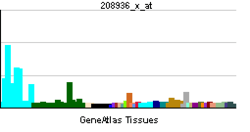Galectin-8
| LGALS8 | |||||||||||||||||
|---|---|---|---|---|---|---|---|---|---|---|---|---|---|---|---|---|---|
 |
|||||||||||||||||
| |||||||||||||||||
| Identifiers | |||||||||||||||||
| Aliases | LGALS8, Gal-8, PCTA-1, PCTA1, Po66-CBP, galectin 8 | ||||||||||||||||
| External IDs | MGI: 1928481 HomoloGene: 31386 GeneCards: LGALS8 | ||||||||||||||||
| |||||||||||||||||
| RNA expression pattern | |||||||||||||||||
   | |||||||||||||||||
| More reference expression data | |||||||||||||||||
| Orthologs | |||||||||||||||||
| Species | Human | Mouse | |||||||||||||||
| Entrez | |||||||||||||||||
| Ensembl | |||||||||||||||||
| UniProt | |||||||||||||||||
| RefSeq (mRNA) | |||||||||||||||||
| RefSeq (protein) | |||||||||||||||||
| Location (UCSC) | Chr 1: 236.52 – 236.55 Mb | Chr 13: 12.44 – 12.46 Mb | |||||||||||||||
| PubMed search | [1] | [2] | |||||||||||||||
| Wikidata | |||||||||||||||||
| View/Edit Human | View/Edit Mouse |
Galectin-8 is a protein of the galectin family that in humans is encoded by the LGALS8 gene.[3][4][5]
Function
This gene encodes a member of the galectin family. Galectins are beta-galactoside-binding animal lectins with conserved carbohydrate recognition domains. The galectins have been implicated in many essential functions including development, differentiation, cell-cell adhesion, cell-matrix interaction, growth regulation, apoptosis, and RNA splicing. This gene is widely expressed in tumoral tissues and seems to be involved in integrin-like cell interactions. Alternatively spliced transcript variants encoding different isoforms have been identified.[5]
Role in cellular defence
Galectin-8 has recently been shown to have a role in cellular defence, against both bacterial cytosolic infection and vacuolar damage.[6] Many intracellular bacteria, such as S. enterica serovar Typhimurium and S. flexneri prefer to replicate inside and outside of the vacuole safety respectively, yet these vacoles may become damaged, exposing bacteria to the host cell cytoplasm. It has been shown that the binding of galectin-8 to the damaged vacuole can recruit autophagy adaptors such as NDP52 leading to the formation of an autophagosome and subsequent bacterial destruction.[6] As knockout experiments of galectin-8 leads to more successful cytosolic replication by S. enterica serovar Typhimurium, it is thought that galectin-8 acts as a danger receptor in defence against intracellular pathogens.[6][7]
Interactions
Galectin-8 has been shown to interact with CD49d,[8] CD29[8] and CD49c.[8]
References
- ↑ "Human PubMed Reference:".
- ↑ "Mouse PubMed Reference:".
- ↑ Hadari YR, Paz K, Dekel R, Mestrovic T, Accili D, Zick Y (Mar 1995). "Galectin-8. A new rat lectin, related to galectin-4". J Biol Chem. 270 (7): 3447–53. doi:10.1074/jbc.270.7.3447. PMID 7852431.
- ↑ Su ZZ, Lin J, Shen R, Fisher PE, Goldstein NI, Fisher PB (Aug 1996). "Surface-epitope masking and expression cloning identifies the human prostate carcinoma tumor antigen gene PCTA-1 a member of the galectin gene family". Proc Natl Acad Sci U S A. 93 (14): 7252–7. doi:10.1073/pnas.93.14.7252. PMC 38969
 . PMID 8692978.
. PMID 8692978. - 1 2 "Entrez Gene: LGALS8 lectin, galactoside-binding, soluble, 8 (galectin 8)".
- 1 2 3 Thurston T, et al. (February 2012). "Galectin 8 targets damaged vesicles for autophagy to defend cells against bacterial invasion". Nature. 482: 414–418. doi:10.1038/nature10744. PMC 3343631
 . PMID 22246324.
. PMID 22246324. - ↑ Huang J & Brumell. (February 2012). "A sweet way of sensing danger". Nature. 482: 316–317. doi:10.1038/482316a. PMID 22337047.
- 1 2 3 Hadari YR, Arbel-Goren R, Levy Y, Amsterdam A, Alon R, Zakut R, Zick Y (July 2000). "Galectin-8 binding to integrins inhibits cell adhesion and induces apoptosis". J. Cell. Sci. 113 (Pt 13): 2385–97. PMID 10852818.
Further reading
- Bidon N, Brichory F, Bourguet P, et al. (2001). "Galectin-8: a complex sub-family of galectins (Review)". Int. J. Mol. Med. 8 (3): 245–50. doi:10.3892/ijmm.8.3.245. PMID 11494049.
- Danguy A, Camby I, Kiss R (2002). "Galectins and cancer". Biochim. Biophys. Acta. 1572 (2–3): 285–93. doi:10.1016/S0304-4165(02)00315-X. PMID 12223276.
- Bidon-Wagner N, Le Pennec JP (2004). "Human galectin-8 isoforms and cancer". Glycoconj. J. 19 (7–9): 557–63. doi:10.1023/B:GLYC.0000014086.38343.98. PMID 14758080.
- Bassen R, Brichory F, Caulet-Maugendre S, et al. (2000). "Expression of Po66-CBP, a type-8 galectin, in different healthy, tumoral and peritumoral tissues". Anticancer Res. 19 (6B): 5429–33. PMID 10697573.
- Hadari YR, Arbel-Goren R, Levy Y, et al. (2000). "Galectin-8 binding to integrins inhibits cell adhesion and induces apoptosis". J. Cell. Sci. 113 (13): 2385–97. PMID 10852818.
- Gopalkrishnan RV, Roberts T, Tuli S, et al. (2000). "Molecular characterization of prostate carcinoma tumor antigen-1, PCTA-1, a human galectin-8 related gene". Oncogene. 19 (38): 4405–16. doi:10.1038/sj.onc.1203767. PMID 10980616.
- Bidon N, Brichory F, Hanash S, et al. (2001). "Two messenger RNAs and five isoforms for Po66-CBP, a galectin-8 homolog in a human lung carcinoma cell line". Gene. 274 (1–2): 253–62. doi:10.1016/S0378-1119(01)00598-4. PMID 11675018.
- Nagy N, Bronckart Y, Camby I, et al. (2002). "Galectin-8 expression decreases in cancer compared with normal and dysplastic human colon tissue and acts significantly on human colon cancer cell migration as a suppressor". Gut. 50 (3): 392–401. doi:10.1136/gut.50.3.392. PMC 1773143
 . PMID 11839721.
. PMID 11839721. - Maier C, Rösch K, Herkommer K, et al. (2003). "A candidate gene approach within the susceptibility region PCaP on 1q42.2-43 excludes deleterious mutations of the PCTA-1 gene to be responsible for hereditary prostate cancer". Eur. Urol. 42 (3): 301–7. doi:10.1016/S0302-2838(02)00280-4. PMID 12234517.
- Strausberg RL, Feingold EA, Grouse LH, et al. (2003). "Generation and initial analysis of more than 15,000 full-length human and mouse cDNA sequences". Proc. Natl. Acad. Sci. U.S.A. 99 (26): 16899–903. doi:10.1073/pnas.242603899. PMC 139241
 . PMID 12477932.
. PMID 12477932. - Levy Y, Ronen D, Bershadsky AD, Zick Y (2003). "Sustained induction of ERK, protein kinase B, and p70 S6 kinase regulates cell spreading and formation of F-actin microspikes upon ligation of integrins by galectin-8, a mammalian lectin". J. Biol. Chem. 278 (16): 14533–42. doi:10.1074/jbc.M207380200. PMID 12569102.
- Ideo H, Seko A, Ishizuka I, Yamashita K (2004). "The N-terminal carbohydrate recognition domain of galectin-8 recognizes specific glycosphingolipids with high affinity". Glycobiology. 13 (10): 713–23. doi:10.1093/glycob/cwg094. PMID 12851289.
- Nishi N, Shoji H, Seki M, et al. (2004). "Galectin-8 modulates neutrophil function via interaction with integrin alphaM". Glycobiology. 13 (11): 755–63. doi:10.1093/glycob/cwg102. PMID 12881409.
- Gerhard DS, Wagner L, Feingold EA, et al. (2004). "The Status, Quality, and Expansion of the NIH Full-Length cDNA Project: The Mammalian Gene Collection (MGC)". Genome Res. 14 (10B): 2121–7. doi:10.1101/gr.2596504. PMC 528928
 . PMID 15489334.
. PMID 15489334. - Arbel-Goren R, Levy Y, Ronen D, Zick Y (2005). "Cyclin-dependent kinase inhibitors and JNK act as molecular switches, regulating the choice between growth arrest and apoptosis induced by galectin-8". J. Biol. Chem. 280 (19): 19105–14. doi:10.1074/jbc.M502060200. PMID 15753078.